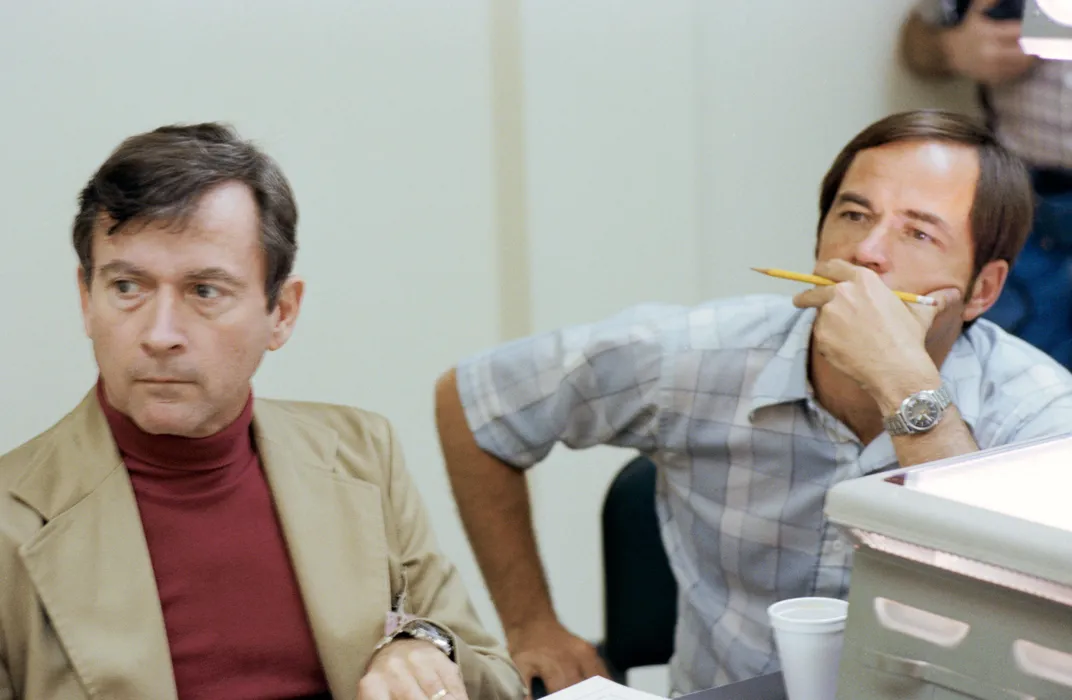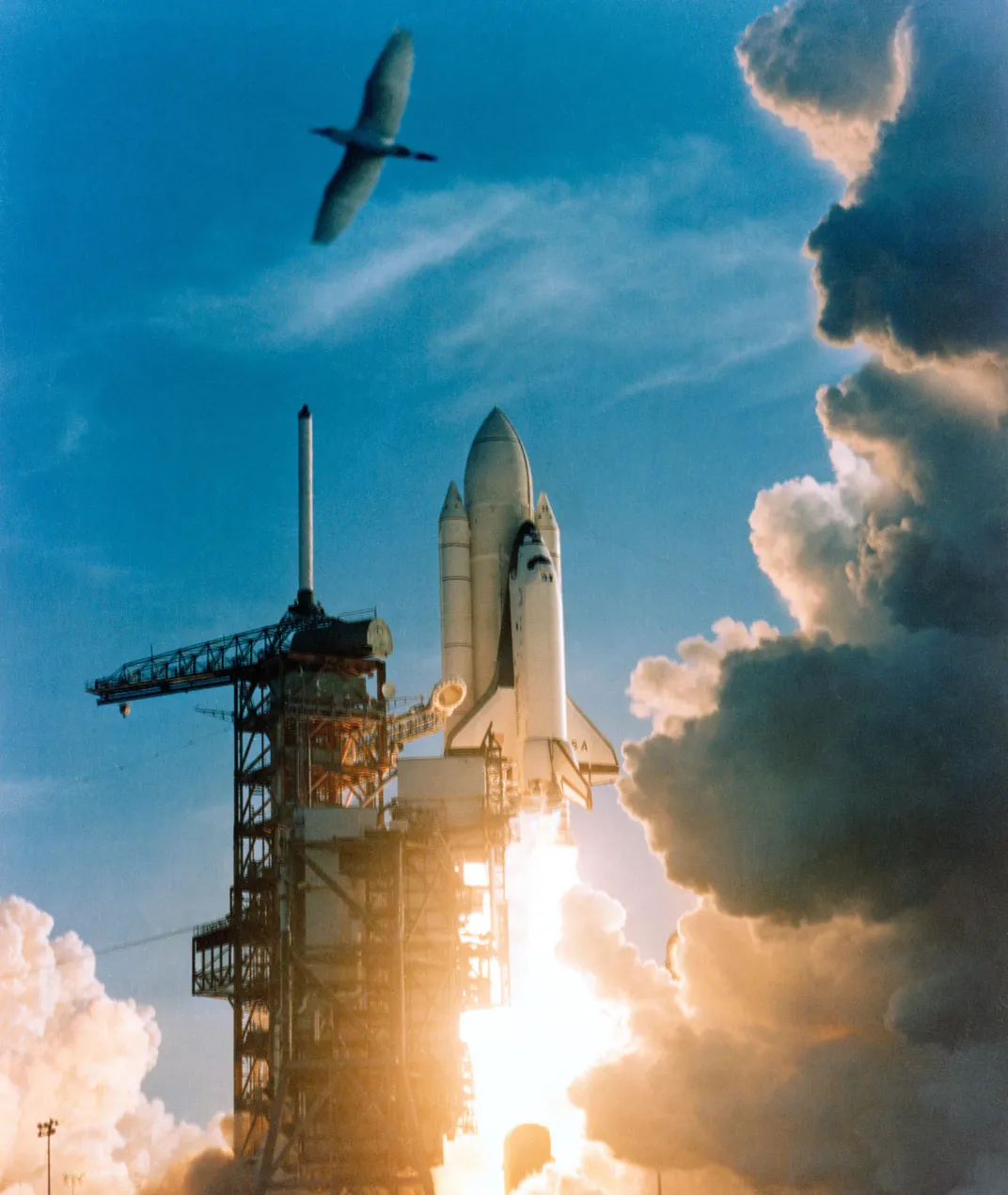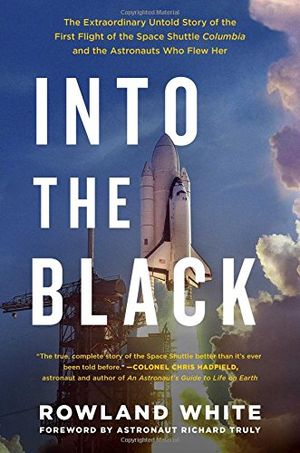The Spysat and the Shuttle
On the first space shuttle mission in 1981, NASA called on a secret eye in the sky.
/https://tf-cmsv2-smithsonianmag-media.s3.amazonaws.com/filer/97/be/97bee3fa-4d8e-4f8f-9e65-a2bdcd0c6eea/s81-33179-orig.jpg)
The first flight of the space shuttle, 36 years ago today, was notable for many things, including the first and only time NASA had launched a brand new spacecraft with astronauts onboard. Until now, few people knew the details of a secret effort to inspect Columbia during its two days in orbit using the KH-11 spy satellite. Writer Rowland White tells the story in this condensed excerpt from the new, revised edition of his history of STS-1, Into The Black, to be published by Touchstone on April 18.
NASA engineer Ken Young pulled up to the Fort Belvoir guardhouse, showed his driver’s license and recited his social security number. It was his first visit to the Aerospace Data Facility East, the ground station on the banks of the Potomac River in Virginia for the National Reconnaissance Office, the secret agency in charge of U.S. spy satellites. And it was the final step in his induction into the world of black ops. As head of the Johnson Space Center’s Flight Planning Branch, Young already had a secret clearance. But when he was called into the shuttle program office by his boss, Ed Lineberry, and [Flight Operations Director] George Abbey’s assistant, Jay Honeycutt, in early 1980, he was told it wouldn’t be enough. For the job they wanted him to do, he required a Top Secret compartmentalized ticket, and it was going to take six months of background checks by the Office of Personnel Management to get it.
NASA, he was told, was going to try to capture images of the space shuttle Columbia in orbit during its maiden flight—planned for the following year—using the NRO’s spy satellites. Fewer than 15 people at JSC were privy to what became known by Lineberry and Young as The Plan. The two of them would have sole responsibility for figuring out the conjunctions between the two orbiting spacecraft. Speed, timing, distance, angles, orientation and lighting all needed to be considered. And they would be the only direct points of contact between NASA, the NRO and the Air Force personnel who operated the KH-11 Keyhole spy satellites out of the Blue Cube in Sunnyvale, California.
Lineberry and Young usually met their defense department counterparts inside a secure room at JSC. Such was the concern over security that at times it almost felt as if the DoD team was talking in tongues. Different scenarios were assigned specific codenames like LAMPPOST, WAGON WHEEL, FIREFLY and WATER GLASS. All had to be memorized by the NASA newcomers. Taking notes was forbidden, as was saying “NRO” out loud.
For Young, this peek into the classified space program was eye-opening. While he was impressed by the people, he was surprised that Air Force mission planning was still mostly a pencil-and-ruler affair. There were computers to run the data, but the timelining was being done on what looked like big rolls of butcher paper. But if the Blue Cube was spartan, the same could not be said of Area 58, the NRO’s Fort Belvoir facility. Even to an engineer who’d cut his teeth on NASA’s moon missions, the sophistication of the computers, photographic and communication equipment inside the building’s plain exterior was a revelation. As the NRO staffers showed him round, Young marveled at what was clearly billions of dollars worth of equipment. It was here that any photographs of the shuttle captured by the spy satellites would be processed. Here that any potential evidence of damage to Columbia’s heat shield—the reason NASA wanted these pictures in the first place—might first be revealed. But only if Ken Young got his math right.
Among the handful of people at JSC briefed on the NRO’s involvement were the primary and backup shuttle crews, who were already training for the first flight. Invited into the vault, the four astronauts listened intently as The Plan was described in detail. After considering what was said, Columbia’s STS-1 Commander, John Young, asked: “Well, what do we have to do in all this?”
‘‘Nothing really,” replied Ken Young, ‘Just perform the maneuvers and orientations we send up. And don’t ask anything on the open loop if some attitude change seems weird or unconventional.”
“OK,” replied the veteran astronaut, “that’s easy.” And on the face of it, it was. But things weren’t to go to plan.

On April 10th, 1981, after John Young and his pilot Bob Crippen had already been strapped in their ejection seats for nearly six hours, the first attempt to launch Columbia from Kennedy Space Center in Florida was scrubbed. A minor computer glitch was revealed to be the cause of the delay. Happily, it proved to be no showstopper.
And so two days later, on the 20th anniversary of Yuri Gagarin’s first spaceflight, the astronauts once again climbed into the cockpit of their spacecraft. The first cold blue light of dawn was beginning to show on the horizon.
An hour and a half before launch, in their secure room on the second floor of Building 30, Ed Lineberry and Ken Young were all set. Over the previous six months their preliminary trajectory for STS-1’s orbital phase had become operational, the data frozen as nominal. Other branches had done the same for launch and re-entry. It was sacrosanct. Had been for months. And, while NASA’s press kit explained that each day the “launch windows opened at local sunrise plus 45 minutes and are more than 6 hours in duration,” Lineberry and Young knew that, while in theory that was right, in practice there was almost no flexibility at all. The two of them had chosen the launch time of 0700 hours EST very specifically. It was when they had determined that the shuttle would have to launch in order to optimize the opportunities for the NRO to capture images of Columbia in orbit.
After the scrubbed launch on April 10, they’d been forced to look again at the scheduled liftoff time and make small adjustments to Columbia’s planned orbital altitude.
Over the months prior to STS-1, they’d asked one of the engineers on the Mission Planning and Analysis team, Dave Scheffman, to modify a special graphics program that would calculate and display the orbiter’s planform—the apparent shape of its underside—in various different orbits, attitudes and lighting conditions. Mainly, they asked Scheffman to model the view from the various radar and telescopes that NASA planned to use to inspect Columbia from the ground. But just occasionally, they’d ask him to take a bird’s eye view from points around an imaginary sphere outside of the shuttle’s orbit. They never gave a reason, and they were never asked for one.
Dave’s most probably figured out, Young thought, that something hush-hush is going on. But Scheffman didn’t probe. Just ran the program.
In the two days following the April 10 launch scrub, using an offline computer in Building 12 next door to Mission Control, he ran views of Lineberry and Young’s revised calculations. All good.
Inside the Blue Cube, though, it was anything but good. With barely an hour and a half to go until the shuttle launch, one of the KH-11 satellites had experienced a major attitude control problem. In racing to correct it, Air Force controllers realized their commands had caused a significant change in their bird’s orbit. And that would affect the timing of its long planned orbital conjunctions with the shuttle. The opportunity to capture images of Columbia was now in jeopardy.
An urgent, encrypted message from the Blue Cube reached Lineberry and Young in Houston: The spy satellite would be travelling along a different state vector than the one they had used to optimize the shuttle’s launch time. As the countdown clock ticked down, Lineberry input the new numbers into the computer to calculate a new liftoff time, which came out two and a half minutes later than planned.
Young called Mission Control on the secure line. Flight Director Neil Hutchinson took it in his stride. “Well,” he said, “we can adjust the liftoff for that easily when we come out of the built-in hold at T minus nine minutes.” Thinking it through, he added “But what am I gonna tell the Launch Director at the Cape is the reason for that little delay?”
“Hell, I don’t know,” Young said. “Just make up something.” Before he could even think of a suggestion, Hutchinson’s voice cut across the Mission Control room’s open loop: “Guys, we may have a small liftoff delay of two or three minutes when we come out of the T minus nine hold. The guys in RTCC [the Real Time Computer Complex] need time to reboot a backup computer.” The supervisor running the RTCC came back quickly: “Hey, Flight, we don’t have to reboot any backup machine...”
Flight Dynamics Officer Jay Greene cut in: “You. Do. Now.”
“OK, FIDO, we’re on it,” came the reply from the computer room.
Listening in to the exchange alongside Young in the secure room, Ed Lineberry continued to type numbers into the HP desktop, running through pre-programmed equations. “Hey,” he turned to Young, his mind racing through the possibilities. The words tumbled out: “We don’t really need to delay liftoff. We can make that two and a half minute shift by just adjusting the two circularization maneuvers up one nautical mile.” Spacecraft weren’t launched straight into their final orbits. Instead, after reaching a safe orbit, they performed a further series of maneuvers to reach the orbit required for the mission. By pushing Columbia a little higher, into a slightly slower orbit, the effect on the conjunctions between the orbiter and the spysat would be similar to that achieved by delaying the launch. Lineberry and Young’s new recommendation was accepted by Mission Control. Columbia would launch on time, but it wouldn’t be without some cost.
By altering the distances between the two spacecraft in orbit, Lineberry and Young had torn up the attitude requirements for capturing the pictures of the shuttle’s heatshield that had been so carefully worked out and confirmed with Dave Scheffman’s help. But, if they stuck to the flight plan as written, all the imaging opportunities would be, at best, less than optimum.
The Plan that had taken weeks and months to refine now needed to be rewritten yet again, so that it could be executed some time during the shuttle’s two-day flight. What Columbia’s Commander, John Young, had so happily described as easy was now a good deal more complicated.

It also became much more critical when, after reaching orbit, Young and Crippen reported that some of the insulating tiles were missing from Columbia’s heat shield. Only photographs taken by the KH-11 satellite would have the resolution to reveal whether or not there was more significant damage. Without the tiles, Columbia’s ability to survive re-entry was unknown.
In the fevered press conferences that followed the revelation of the missing tiles, NASA spokespeople were unable to answer reporters’ questions about plans to capture images of Columbia using satellites. In 1981, even the existence of the NRO was classified. “We don’t have any specific plans for that type of work,” was all that Gene Kranz, JSC’s pugnacious Deputy Director of Flight Operations, could tell reporters.
Meanwhile, Ed Lineberry and Ken Young were working on it. Using the revised KH-11 and shuttle orbits, they calculated new sets of coordinates to be sent up to Columbia’s crew. Each new instruction—time of ignition, duration of burn and the orbiter’s post-burn orientation described in three axes—was verified by Dave Scheffman. He would go up to the second floor secure room, printed computer graphics in hand, and because he wasn’t cleared to actually enter, slide them under the door in a plain envelope.
Over the course of the 54-hour mission, there were just three brief opportunities for the NRO’s bird to capture images of Columbia. Each window was barely a minute long. For any chance of success, Young and Crippen had to maneuver the spacecraft in response to the coordinates worked out by Lineberry and Young and sent up to them by Mission Control. They also needed to be lucky.
As the astronauts slept on the last night of the mission, Gene Kranz finally was able to share with Mission Control photos showing that the handful of tiles known to be missing represented the full extent of the loss. Critical areas of the heat shield remained intact. Columbia was safe. And a little after 18:20 UTC on April 14, 1981, John Young brought the orbiter home to Edwards Air Force Base for a perfect landing. He and Crippen were rightly hailed for completing what was described as the boldest test flight in history.
One particular detail never made it into the newspapers. While in orbit, the astronauts had actually caught sight of the KH-11 spy satellite through the thick glass of Columbia’s flight deck. Although they were never closer than 60 miles, the darkness of space and a glint of sunlight provided the astronauts with a glimpse of the Top Secret bird. It was information they could share with only a handful of people.
In Sunnyvale, five of the Air Force Satellite Test Center controllers were awarded the Air Force commendation medal for “their crucial support during the shuttle mission.” They were unable to tell their families why.
For Ken Young and Ed Lineberry, there was no official word of thanks. A year later, though, Young’s secretary brought him a small package wrapped in brown paper. Inside was a white coffee mug. On it was printed a light blue rectangle, framing the silhouette of a swooping bird in the same color. Top left was a dime-sized yellow moon. Beneath the graphic were the words:
A DECADE OF EXCELLENCE 23 SEPT. 1971 - 23 SEPT. 1981
A much appreciated token of gratitude from the black world, Young kept it on his desk. But the source of the unfamiliar-looking mug remained classified. If asked about it, he could only shrug and say, “I don’t know. Somebody just left it here after a meeting, I guess.”
